Latest News
AMGTA Shares Findings on Sustainability of Powder and Wire Additive Feedstock
MATLABS Features Modelithics EXEMPLAR Library
Fictiv Demonstrates New AI Capabilities
ADDMAN Earns Qualification Project for U.S. Navy
FREE WEBINAR May 7: Addressing the Skilled Worker Shortage with Customized eLearning
America Makes’ Spring 2024 TRX Explores AM Advancements
All posts
May 26, 2007
By Al Dean
Surface modeling is a powerful tool — something that very few of us could argue with. But the facts are that while it’s the most powerful way to define complex, sculpted surfaces and retain high quality, there is a distinct learning curve involved.
To define a well-constructed surface you need to create a four-sided surface, which is derived from the curves that define its form. The ideal surface is constructed from four curves, each opposite pair (e.g., top and bottom, left and right) having the same number of control points. This allows you to build the curvy, sculpted surfaces you typically create. Some systems do this explicitly, so you can see exactly what you’re doing. Others obscure the process using automated features for surface creation. The problems typically revolve around the uniformity necessary in the construction of the model you are working on. To achieve the required form and to create good surfaces, you have to split the form into patches that conform to the requirements of the NURBS creation process. And that takes skill and expertise.
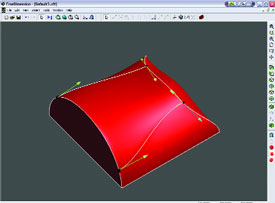 The N-sided Surfacing technology (NSS) used in FreeDimension allows you to create surfaces based on curves, and it allows you to create a network of curves with any number of surfaces. | 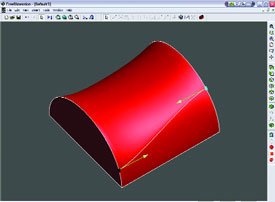 Instead of trimming, FreeDimension’s sliders and Ties workflow along with automatic surface creation mean that its curve-driven worfkflow makes the creation of organic and sculpted forms much easier than has traditionally been the case. |
For simple forms, this isn’t a problem, but as soon as you start to get intersecting areas of geometry, which do not lend themselves to a uniformly constructed four-sided patch, you’re in expert territory. This is why an A-Class surfacing expert using CATIA, NX, ICEM or another program is well paid. They’ve got the knowledge to convert what’s required — in terms of aesthetic quality — into an accurate form using this arcane method of creating the geometry.
A new program called FreeDimension does away with the four-sided construction method. It does this by taking a different surface geometry creation method that’s been around since the 1970s and finally packaging it as a deliverable product. We got the chance to test drive a beta of FreeDimension 1.2.
FreeDimension, founded by a group of technologists with deep behind-the-scenes experience at early CAD industry heavyweights, uses N-Sided Surfacing (NSS) as the key to the whole concept. NSS allows you to create surfaces based on any number of curves. It allows you to create a network of curves with any number of surfaces as the algorithms to create the surfaces exist in the background.
But what advantage does this give? Well, it eliminates trimming.
Once you have your surfaces in place, you typically need to trim them by working through a tortuous process of intersecting surfaces, creating blends, fillets and transitional surfaces to take the model from being a bunch of surface entities to something that resembles the final product. Many of the mainstream modeling tools hide this in an automated feature, but those who use advanced surfacing tools or surface-specific applications know what I’m referring to.
Here, the NSS-based geometry creation process does away with complex trimming functions and allows you to work in a more flexible manner. It does this because the system builds everything from a single set of curves and creates the surface automatically, rather than by the create curve-create surface-trim surface workflow that is most common.
User Interface
The interface is pretty sparse and as you might imagine from a system billed as a conceptual modeler, the functions are pretty well hidden away in a discreet set of toolbars and icons. When starting a new model, you’re presented with the default shape, a half cylinder. But while this provides a convenient starting point, you’re more likely to create geometry from scratch. You have a full range of workplane creation tools that allow you to lay out your curve network, and this is really key to the whole system and the input from which everything else is defined.
You create a shape in any number of ways, but the predominant way is to start with a basic lump of geometry, then add curves to it to get its form. Curves are added in one of two ways: first, by scratch using a 3D manipulator that allows you to find specific positions in space; second, by adding them into an existing basic network — typically by selecting two or more curves between which you run another curve.
While traditional surface modeling has a workflow that goes against design intent, with FreeDimension, the curves you create define the design intent in terms of feature lines. A newly added curve splits the surface, but each end is attached to the edges.
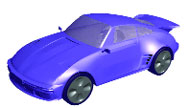 FreeDimension has a stripped down set of tools with which you can conceptualize a product in 3D using feature lines and details. | 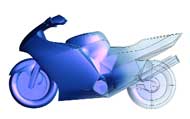 If you create the feature lines, then the surfaces are created as a result, rather than having multiple steps in between. | 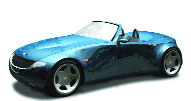 This curve-based workflow offers rapid concept-ualization. As you create curves, your model is presented onscreen, in real time. |
Ties and Sliders
At each intersection point between two curves, you obviously have an intersection entity and these come in two interchangeable forms — Ties and Sliders — and understanding how these work and where you apply them is key to how the system operates. Essentially, if you want to maintain a curve that is attached to another, but alter its position along that curve, you use a slider. It allows you to slide that curve point along the other curve to get the position you want.
This works for positioning a curve in respect to the existing geometry. But if you want to make edits to the position of that point in space, edit the tangency from those curves, then you need to convert the Slider to a Tie. You simply select the point and convert it using either the context-sensitive right click menus or the pull-down menus. This then gives you control over that point’s position in space as well as tangency controls over the two curves that interact with it.
Curve manipulation
Alongside this, you have other ways of changing the behavior of curves. Linear curves can be converted to circular curves, which provides you with a quick way of integrating some styling at a very root level. Control points can be added where needed, and of course, you can build up as many curves within your network as needed to define the form of your part. There are also controls for mirroring and half-sided working where you’re working on a symmetrical part, so you simply edit one side and the changes are propagated across the plane of symmetry.
You might have noticed there’s nothing here about creating a surface. And this really is key to FreeDimension — it creates the surfaces as you build the network of curves, adapting to your input. What I find most interesting is the manner in which you interact with the curves and their control points to define the geometry and the system does the donkey work. Simple as that.
Compelling Conceptualizer
The theory behind FreeDimension is entirely valid. Surface-based modeling does have real restrictions in a production environment and as we’ve said, there are issues relating to the construction of high-quality surfaces. Much of this revolves around this idea that the designer constantly has to take the required intent in terms of form and shape and do some mental gymnastics to achieve that with four-sided NURBS surfaces.
FreeDimension differs in that it has a stripped down set of tools with which you can conceptualize a product in 3D using the input directly from your ideas — feature lines and details. If you create the feature lines, then the surfaces are created as a result, rather than having multiple steps in between — the one is derived from the other rather than needing explicit steps.
It’s clear that the curve-based workflow offers serious advantages in terms of rapid conceptualization of a product form. As you build your curves, your model is presented onscreen, in real time and is eminently editable. Where the product fails is in several key areas that need to be addressed. Firstly, there is little in the way of aesthetic evaluation of your form. Getting an eye on a 3D model is one thing, but in today’s world where aesthetic quality is paramount in many more industry sectors than has historically been the case, you need to perform more evaluation of your form. Curvature and tangency analysis, using sections with hedgehog plots to show inflection point, zebra striped shading and such — all of these tools are conspicuous by their absence.
There were also some issues relating to getting data into the system and out of it in version 1.1 — but much of this is addressed in release 1.2. As it stands, FreeDimension is a conceptual modeling tool that offers an incredibly compelling alternative to the manual processes involved in surface modeling. The good news is that in terms of cost, the application is $495 for the standard version. NURBs will be free while it’s in test, but when formally released, will become a cost option (which seems a little heavy) around the $295 mark when it ships. Upgrades will remain free until Version 3.0.
I’d encourage anyone with an interest to download the trial version and try out the system and see exactly how it works. It’s a fascinating entrant into a market that many see as being mature and staid and deserves, as it develops over the coming months and years, to be seen by as many designers and engineers as possible.
More Information
Al Dean is technology editor at MCAD Magazine, a UK product development and manufacturing technology journal (mcadonline.com) and is editor of Prototype magazine (prototypemagazine.com). You can send comments about this article here.
Subscribe to our FREE magazine, FREE email newsletters or both!
Join over 90,000 engineering professionals who get fresh engineering news as soon as it is published.
Latest News
AMGTA Shares Findings on Sustainability of Powder and Wire Additive Feedstock
MATLABS Features Modelithics EXEMPLAR Library
Fictiv Demonstrates New AI Capabilities
ADDMAN Earns Qualification Project for U.S. Navy
FREE WEBINAR May 7: Addressing the Skilled Worker Shortage with Customized eLearning
America Makes’ Spring 2024 TRX Explores AM Advancements
All posts
About the Author
DE’s editors contribute news and new product announcements to Digital Engineering.
Press releases may be sent to them via [email protected].
#9537
New & Noteworthy

New & Noteworthy: Safe, Cost-Effective Metal 3D Printing - Anywhere
Desktop Metal’s Studio System offers turnkey metal printing for prototypes and...

New & Noteworthy: Direct Neutronics Analysis on CAD
Coreform Cubit 2023.11 workflows enable neutronics directly on CAD for next-generation nuclear energy...

New & Noteworthy: Agile Engineering Collaboration
Authentise Threads is a new software tool for distributed communications and project...

New & Noteworthy Product Introduction: Enterprise VR Headset
Lenovo ThinkReality VRX has an immersive display works with virtual, augmented and...


